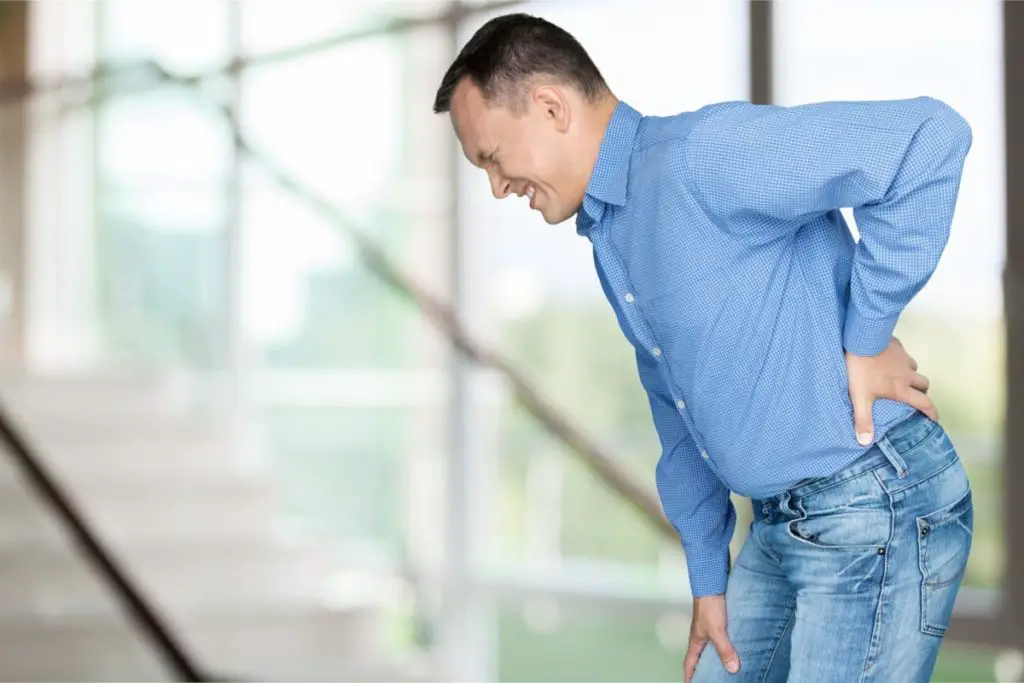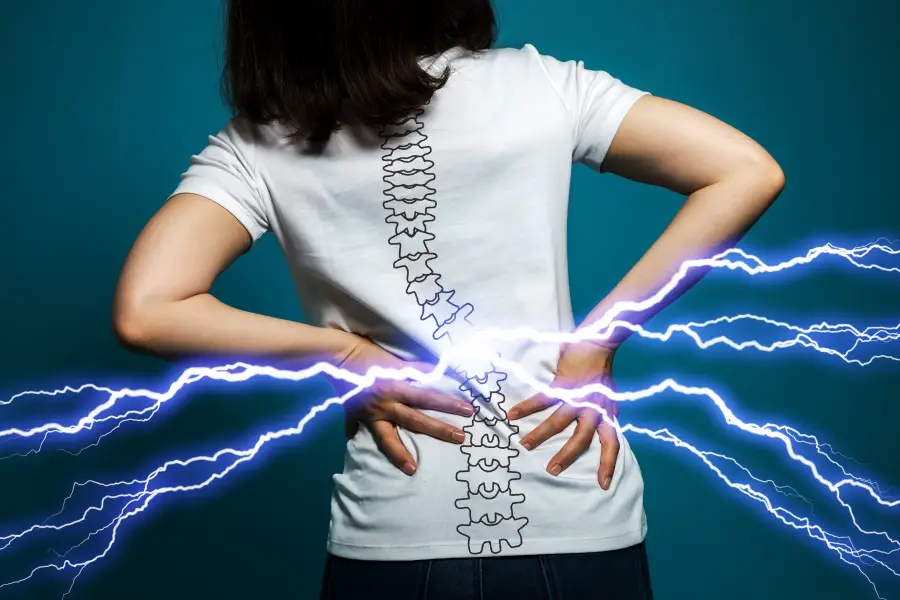Le lumbago represents a major public health problem both in terms of its frequency and the long period of disability for which it is responsible.
How long does lumbago last? And how to prevent it? Answers in this article.
What is lumbago?
Lumbago also called common low back pain, kidney tower ou lumbar sprain, denotes a lower back pain (therefore located in the lower back) without irradiation and without warning or serious signs. She is usually acute, high intensity and gives the feeling of having the back "blocked ».
It reflects an inflammatory process affecting the musculoskeletal structures of the lumbar region, namely the ligaments, muscles and tendons. This process can be secondary to overstretching or spasm of a muscle, a small tear in a ligament, or irritation of a joint.
It is possible to distinguish different types of low back pain:
- La chronic low back pain : whose duration is more than three months.
- Low back pain known as “at risk of chronicity”: when the duration of low back pain is less than three months but it presents risk factors for becoming chronic.
- Recurrent low back pain: this is the occurrence of several episodes of low back pain at risk of chronicity during the year (over 12 months).
- Acute low back pain or lumbago: it is a transient episode lasting an average of six weeks.
The occurrence of lumbago can be favored by certain risk factors, in particular:
- THEage: over 50 years old, although it appears more and more in young subjects due to lack of physical activity;
- La inactivity;
- Le overweight;
- La physical load due to work or a domestic or leisure activity;
- The psychosocial conditions such as stress, depression, performing monotonous tasks...
To know everything about lumbago, see the following article.
What are the symptoms of lumbago? And how is his diagnosis made?
The main clinical manifestation of lumbago is pain located in the lumbar region. It is brutal, of high intensity, generally does not radiate anywhere, and occurs during physical exertion.
It can be accompanied by a stiffness or spasms in the muscles of the lower back and an impression of " blocked back ».
The lumbago being due to an inflammation of tissues called " mous » such as ligaments or muscles, its diagnosis is purely clinical. It is based on a good interrogation and clinical examination of the doctor.
A plain x-ray may be requested to rule out other causes of low back pain such asOsteoarthritis, but this is rarely the case. Biological assessments are also only requested with the aim of looking for another etiology of the pain such as a rheumatism.
What can cause lumbago?
The term " common low back pain is opposed to that of specific low back pain which is related to a pathology affecting the spine such as Scoliosis, infection, tumor or fracture.
Common low back pain or lumbago represents an entity that is not related to an underlying disease. Rather, it occurs in the course of a " false move » causing muscle, ligament or tendon damage.
The term " false move encompasses different everyday situations, namely:
- A sudden movement of the pelvis;
- A major effort made in a bad posture;
- Lifting a heavy load while having the curved back ;
- A fit of coughing or sneezing;
- A fall or trauma to the lower back without bone damage;
- Prolonged sitting or repeated movement overloading the lower back.
Finally, lumbago can also be the consequence of muscle tension caused by a stress important and prolonged, or of a psychological distress important as the trough.
How long does lumbago last?
Although the intensity of the pain and the feeling of blockage can give the impression that it is a serious attack that can go on forever, the average duration of lumbago is in nine out of ten cases, less than six weeks.
Good initial care including moderate and appropriate physical activity, the avoidance of predisposing factors, analgesics and physical means such asapplying heat to Massages help reduce the duration of acute low back pain.
Factors Influencing Healing Time
La duration of a lumbago strongly depends on factors related to the type of pain, lifestyle and habits of the patient. Thus, lumbago can last longer or shorter if:
- The pain begins to radiate elsewhere than in the lower back: it is obvious that lumbago is defined as lumbar pain without radiation, but it can happen that it worsens following the compression of a nerve root, thus giving of the radiculalgia associated. This is the case, for example, during the cruralgia or sciatica.
- The patient does not improve the quality of his sleep, does not maintain a reasonable weight or continues to lead a sedentary lifestyle: the practice of physical activity generally solves all of these problems.
- The psychological state of the person suffering from lumbago remains the same, it is imperative to have a good state of mind and reduce stress when suffering from lumbago.
How to prevent the occurrence of lumbago or its recurrence?
Suffering from lumbago is not a very pleasant situation, that goes without saying. It is therefore essential to know the right actions to prevent its occurrence or, if necessary, its recurrence.
Some measures can therefore be taken to avoid or no longer relive this unpleasant situation, such as:
- Practice a suitable sporting activity on a regular basis: whether it's walking, running, swimming or any other physical activity. Moving and strengthening your back are the best allies you can have to avoid back pain.
- Change your habits et improve your lifestyle: eating healthier, avoiding a sedentary lifestyle, sleeping properly and avoiding stressful situations are excellent measures to take in order to protect your back.
- Adopt the right gestures et postures when using your back: in particular bending your knees while keeping your back straight instead of bending it when carrying a heavy load or keeping your back straight and your feet flat during prolonged sitting.
References
Lumbago: sleeping positions (advice)
3 exercises to do after lumbago (in video)
Lumbago: Should we walk or rest? (explanation)
https://www.passeportsante.net/fr/Maux/Problemes/Fiche.aspx?doc=lumbago
https://www.doctissimo.fr/html/sante/encyclopedie/sa_1587_lumbago.htm
My name is Sidali. I am a general practitioner and Web Editor. As a healthcare professional, my mission is to contribute to the relief of my patients' ailments. Being also passionate about writing, I have the pleasure of sharing my solid medical knowledge with the greatest number of readers, by writing popular articles that are very pleasant to read.









